This article is a member benefit of the Penn State Alumni Association
Members have full online access to current and past issues, as well as to member-exclusive bonus content.
- Connects you to a network of more than 700,000 Penn Staters worldwide
- Gives you exclusive perks including the Penn Stater magazine
- Supports networking, career and mentoring programs, and events including THON and Homecoming
Click below to explore all membership perks and start enjoying the benefits today!
